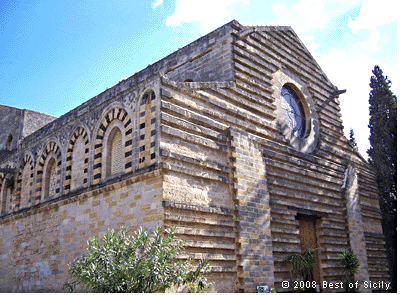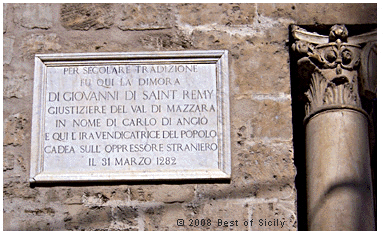...Best of Sicily presents... Best of Sicily Magazine. ... Dedicated to Sicilian art, culture, history, people, places and all things Sicilian. |
by Vincenzo Salerno | |||
Magazine Index Best of Sicily Arts & Culture Fashion Food & Wine History & Society About Us Travel Faqs Contact Map of Sicily
|
The revolt quickly spread around the capital and across the island. The frenzied populace killed Frenchmen wherever they found them. Even monasteries were not exempt from their fury. French monks and nuns were killed. There seems to have been at least one case of a Sicilian woman pregnant by her French husband being cut open based on the idea that her unborn child was French. In a largely multicultural society, it was necessary to identify the French, so the revolutionaries devised a simple linguistic test: pronounce the word "ciciri" (not "Cicero" as some "internet writers" have stated). No Frenchman could pronounce it with an acceptably Sicilian accent (by now a Latin-based Sicilian language existed). As the weeks passed, some French were simply deported. A few who should have been deported were killed. The justiciar for western Sicily, John of Saint Rémy, took refuge in the mountains and was killed at the castle of Vicari when an overzealous archer fired an arrow upward into a window and hit him. Saint Rémy otherwise would have been allowed safe conduct off the island. (His residence in Palermo, now part of Saint Ann's Monastery, the modern art gallery near Palazzo Gangi, is commemorated by an inscription shown below.) In contrast, the vice-justiciar for western Sicily, the benevolent William de Porcelet, like Saint Rémy a Provençal, was escorted with his family from Calatifimi to Palermo and permitted to leave. At Sperlinga, the French garrison was permitted to depart for Messina, which did not join the movement for several months. Whether the revolt began in the evening, around the time of Vespers, is not known with certainty, but the Church of the Holy Spirit, once set in a park outside the city walls, still stands. (Shown here, it is in the middle of the cemetery today, thus rarely visited by tourists.) Thousands of Angevin-French were killed as the revolt quickly spread around Sicily and the populace, led by the baronage, took control of civil and military affairs, eventually offering the island to Peter of Aragon, whose wife, Constance, as the daughter and heir of King Manfred of Hohenstaufen, represented the Swabian dynasty of Frederick II. The Aragonese fleet eventually arrived and for the next five centuries Sicily found herself in the Spanish orbit. The revolt stands out in the annals of medieval politics as a unique and unprecedented example of a general population successfully removing its monarch from power. In the geopolitical sphere, the Vespers war literally changed the face of European and Mediterranean power politics, effectively rearranging the pieces of a complex chess board. It also served as a warning to European rulers that under certain circumstances the ruled, including not only the aristocracy but also the common people, could seize power, in the process causing a dynasty or two to tumble. What saved Charles of Anjou (and his immediate successors) was that the fall of the island of Sicily did not precipitate his deposition in southern mainland Italy, the northern half of what, following the Vespers, became known as the "Two Sicilies." Until then, under the Normans and Swabians, the entire region south of Rome (including Sicily proper) was collectively the Kingdom of Sicily. Charles of Anjou, better known for being the younger brother of Saint Louis, had ruled Sicily from Naples (as "Charles I") since 1266. With Papal support, Charles aspired to control much of the central and eastern Mediterranean, including Byzantine and Arab lands. His plans for a "crusade" to take Constantinople were thwarted by the Vespers war which, in fact, was the result of at least some form of planning, if not outright conspiracy, by nobles sympathetic to the Ghibelline cause. The Ghibellines supported the authority of the Holy Roman Emperor in Italy while the Guelphs supported the authority of the Pope and later Charles' House of Anjou, which was "appointed" by the Papacy to the Sicilian-Neapolitan throne; these movements were more evident in the patchwork of cities and fiefs of northern and central Italy than in the south, where there was wider support for the Hohenstaufens. By 1268, following the Hohenstaufens' defeat by Angevin forces at the Battle of Tagliocozzo and the execution of the young Conradin, the last male Hohenstaufen, the rivalry between Guelphs and Ghibellines seemed to have been relegated to the pages of historical chronicles. It would be imprecise to view modern ideas of "French" or "German"
nationalism in these medieval parties. However, by 1266 the Ghibellines
were essentially a party of Swabian sympathy while the Guelphs were supporters
of Angevin rule. After 1268, though the Ghibelline movement doubtless existed
in some form, it had moved "underground" and began to exploit
the growing mood of rivalry between the Angevins and Aragonese. Charles
felt confident enough in his own authority to move the capital of the Kingdom
of "Sicily" to Naples. This was to prove a fateful decision, though
just one of several major errors. The Vespers uprising of 1282 was followed by a series of sea battles and raids, and a few skirmishes on land between Angevin and Aragonese knights which continued into 1283. At one point Charles "the Lame," Prince of Salerno (later Charles II), eldest son and heir of King Charles, was captured and imprisoned in the fortress overlooking Cefalù. Perhaps the most bizarre "non-event" was the duel scheduled between King Charles and King Peter to resolve the conflict at Bordeaux; each suite conveniently arrived at the designated site in the French domain of King Edward I of England at the wrong hour, and could thus claim the cowardice of the opposing side. Only in August 1302, with a treaty known as the "Peace of Caltabellotta," peace finally achieved between the Angevins and Aragonese, agreed between Charles II of Naples (his peninsular realm referred to as "Sicily") and King Frederick of Sicily (or "Trinacria," according to the terms of the treaty), a son of Peter of Aragon. Thus did chroniclers coin the phrase "the Two Sicilies," which later denoted the Bourbons' unified Kingdom of Naples and Sicily from 1734 until 1860. Yes, the uprising and subsequent war destroyed the strategic Mediterranean ambitions of Charles I, and this was probably the reason for the initial conspiracy undertaken by John of Procida with the aid of the Emperor of Constantinople and the King of Aragon, even if the details and scope of this planning may never be known. There is, however, little doubt regarding Byzantine financial assistance and Aragonese military support. In the event, it was widespread resentment of Charles' ruthless policies and methods that facilitated the co-operation, in such a grand plan, of baron and peasant alike. On another level, the Papacy seems to have envisaged, through Charles' proposed "crusade" to Constantinople, a unification (under the Pope of Rome) of what by 1282 had become the Catholic and Orthodox churches, a result of the deeply divisive Schism of 1054. Leaving aside the theological implausibility of this idea, it was not to be realised. As it happened, the War of the Vespers diverted military attention away from Palestine and the Crusader states. The fall of Acre in 1291 signalled the end of the Christian presence in the Middle East, and while the Vespers were not directly responsible for this, the Christian position would have been bolstered greatly had Charles and his contemporaries been able to send reinforcements instead of becoming hopelessly entangled in what was essentially a domestic war. At the very least, the Latin Kingdom of Jerusalem might have survived for a few more years. Dante was not very charitable to Charles and his ilk. More recently, Giuseppe Verdi's opera was inspired by the Vespers war. The definitive history is Steven Runciman's book, The Sicilian Vespers - A History of the Mediterranean World in the Later Thirteenth Century. John Julius Norwich authored a book (The Middle Sea - A History of the Mediterranean) which also places the Vespers into a wider context. About the Author: Palermo native Vincenzo Salerno has written biographies of several famous Sicilians, including Frederick II and Giuseppe di Lampedusa. | ||
Top of Page |
 History, embellished
with a generous dose of legend, tells us that the War of the Vespers, a signal
event in the Mediterranean and Europe during the late thirteenth century,
began as a popular revolt on Easter Monday (30 March) 1282 when a French
soldier decided to search a Palermitan woman for weapons, offended her modesty
and enraged some local people into a spontaneous uprising near what is now
a local cemetery.
History, embellished
with a generous dose of legend, tells us that the War of the Vespers, a signal
event in the Mediterranean and Europe during the late thirteenth century,
began as a popular revolt on Easter Monday (30 March) 1282 when a French
soldier decided to search a Palermitan woman for weapons, offended her modesty
and enraged some local people into a spontaneous uprising near what is now
a local cemetery.